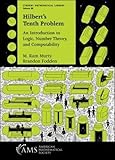Hilbert's Tenth Problem : An Introduction to Logic, Number Theory, and Computability,
Language: English Series: Student Mathematical Library ; 88Publication details: Rhode Island American Mathematical Society 2019Description: xiii, 237pISBN: 9781470443993 (PB)Subject(s): Number theory | Mathematical recreations and problems | Field theory and polynomials | Mathematics BOOKS
List(s) this item appears in:
New Arrivals (01 May 2024)
BOOKS
List(s) this item appears in:
New Arrivals (01 May 2024)
| Current library | Home library | Call number | Materials specified | Status | Date due | Barcode |
|---|---|---|---|---|---|---|
| IMSc Library | IMSc Library | 512 MUR (Browse shelf (Opens below)) | Available | 77671 |
Includes Bibliography (229- 232) and Index
1. Introduction
2. Cantor and infinity
3. Axiomatic set theory
4. Elementary number theory
5. Computability and provability
6. Hilbert’s tenth problem
7. Applications of Hilbert’s tenth problem
8. Hilbert’s tenth problem over number fields
9. Background material
Hilbert's tenth problem is one of 23 problems proposed by David Hilbert in 1900 at the International Congress of Mathematicians in Paris. These problems gave focus for the exponential development of mathematical thought over the following century. The tenth problem asked for a general algorithm to determine if a given Diophantine equation has a solution in integers. It was finally resolved in a series of papers written by Julia Robinson, Martin Davis, Hilary Putnam, and finally Yuri Matiyasevich in 1970. They showed that no such algorithm exists.
This book is an exposition of this remarkable achievement. Often, the solution to a famous problem involves formidable background. Surprisingly, the solution of Hilbert's tenth problem does not. What is needed is only some elementary number theory and rudimentary logic. In this book, the authors present the complete proof along with the romantic history that goes with it. Along the way, the reader is introduced to Cantor's transfinite numbers, axiomatic set theory, Turing machines, and Gödel's incompleteness theorems.
Copious exercises are included at the end of each chapter to guide the student gently on this ascent. For the advanced student, the final chapter highlights recent developments and suggests future directions. The book is suitable for undergraduates and graduate students. It is essentially self-contained.


There are no comments on this title.